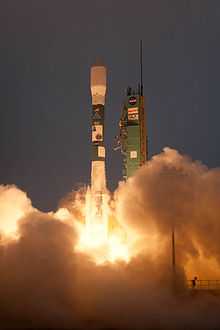SAC-D
SAC-D (Spanish: Satelite de Aplicaciones Cientificas-D, meaning Satellite for Scientific Applications-D), also known as Aquarius after its primary instrument, is an Argentine Earth science satellite built by INVAP and launched on June 10, 2011.[2] It carries seven instruments to study the environment, and a technology demonstration experiment.[3] Its primary instrument, Aquarius, was built by and is operated by the United States National Aeronautics and Space Administration. SAC-D is operated by CONAE, the Argentine space agency. The satellite is expected to operate for five years; however the Aquarius instrument is only expected to operate for three.[4]
Launch

Launch of the Aquarius/SAC-D observatory.
SAC-D was launched on June 10, 2011.[5] A Delta II 7320-10 was used as the launch vehicle, taking off from Space Launch Complex 2W at Vandenberg Air Force Base. NASA was responsible for providing launch services,[6] which were subcontracted to United Launch Alliance. The launch was delayed from May 2010 because development of the spacecraft was taking longer than expected.[7]
Instruments
| Name |
Operator |
Purpose |
| Aquarius |  NASA NASA | Ocean salinity research |
| CARMEN I |  CNES CNES | Two experiments: SODAD will study particles and debris in space, ICARE will study cosmic radiation and its effects on electronics |
| DCS |  CONAE CONAE | Collection of data provided by platforms on Earth. Compatible with Argos System |
| HSC |  CONAE CONAE | Imaging of aurorae, fires, and lights |
| MWR |  CONAE CONAE | Radiometry |
| NIRST |  CONAE CONAE
 CSA CSA | Infrared imagery, determination of sea temperatures |
| ROSA |  ASI ASI | Measurement of temperature and humidity in the atmosphere |
| TDP |  CONAE CONAE | Technology demonstration involving GPS navigation and inertial guidance[3] |
See also
References
External links
 |
Wikimedia Commons has media related to Aquarius. |
|
|---|
| | Satellites |
- Past and current
- MuSat (1996)
- SAC-B (1996)
- SAC-A (1998)
- SAC-C (2000)
- Pehuensat
- SAC-D/Aquarius (2011)
- In development
- SAOCOM-1A (2014)
- SAOCOM-1B (2015)
- SAC-E/SABIA (2017)
- SAC-F/ALSAT-2
|
|---|
| | Rockets | |
|---|
| | Projects |
- In development
- VS-30 payload project
|
|---|
| | Launch sites | |
|---|
| | Institutions | |
|---|
|
|
|---|
| | | Payloads are separated by bullets ( · ), launches by pipes ( | ). Manned flights are indicated in bold text. Uncatalogued launch failures are listed in italics. Payloads deployed from other spacecraft are denoted in (brackets). |
|

